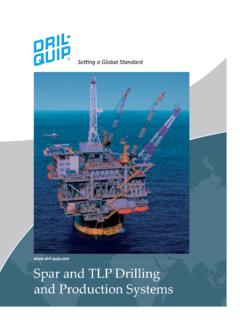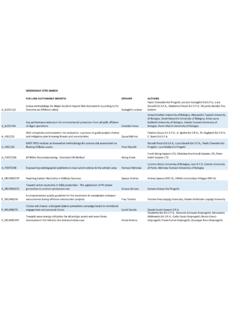Transcription of ED Offshore Inspection Guide - Health and Safety Executive
1 Page 1 of 29 TRIM 2017/368037 ED Offshore Inspection Guide Wells Personnel Competency Management System Inspection Guide Contents Summary Introduction Action Background Organisation Targeting Timing Recording and Reporting Appendix 1 Inspection Guidance Documentation review Appendix 2 Inspection Guidance Role specific questionnaires Appendix 3 Inspection Guidance System overview Appendix 4 Performance Rating SUMMARY This Inspection Guide (IG) sets out the Energy Division - Offshore approach to the Inspection of the management of competency of wells personnel engaged in oil or gas well operations either Offshore on the UK Continental Shelf or onshore in Great Britain. The Guide provides a question set to be used as a basis for a wells personnel competency management system Inspection .
2 This has been developed from a background of HSE and industry guidance on Competency Management Systems. The Guide provides the basis to assess any risk gap as defined by HSE s Enforcement Management Model, and hence the Duty Holder s Performance Score which will feed into the intervention planning process. Introduction Competence is a very broad subject area that may span the length and breadth of an organisation, and the competency requirements for personnel involved in well engineering and operations activities will be different dependent upon the organisation s activities, the job position, the tasks to be undertaken and the associated risks. The work activities and tasks carried by different organisations will be different dependent upon their roles as mobile Page 2 of 29 TRIM 2017/368037 and fixed installation drilling rig duty holders, or as well operators, or as third party service providers.
3 Major hazard organisations require competent staff that have the necessary skills, knowledge and experience to undertake critical tasks in such a way as to prevent a major accident or minimise the consequences to people and the environment, should one occur. Competence means the ability to undertake responsibilities and perform activities to a recognised standard on a regular basis. Competency is a combination of practical and thinking skills, experience and knowledge, and may include a willingness to undertake work activities in accordance with agreed standards, rules and procedures. Competency depends on the context and the environment in which the activity is performed, and on the working culture of the organisation. Competence Management means the arrangements to control, in a logical and integrated manner, a cycle of activities within the organisation that will assure, and develop, competent performance.
4 The aim is to ensure that individuals are clear about the performance that is expected of them, that they have received appropriate training, development and assessment, and that they maintain, or develop, their competence over time. Action The aim of this Inspection Guide (IG) is to provide information and guidance to Offshore inspectors to support the delivery of consistent and effective competence assessments of Offshore wells personnel. It does this by highlighting key areas essential to an effective competence assessment process, so that these can be covered during inspections, providing a framework for inspectors to judge compliance, assign performance ratings, and decide what enforcement action to take should they find legislative breaches. In doing so, it complements HSE s Enforcement Policy Statement (EPS) and Enforcement Management Model (EMM).
5 Inspectors undertaking a Wells Competency Management System Inspection will need to be familiar with the Oil and Gas UK Guidelines on competency for Wells Personnel. A set of model responses is provided along with a questionnaire (see Appendix 1). These provide the interpretive standard against which the Enforcement Management Model (EMM) risk-gap should be assessed and hence the Duty Holder s performance Score in relation to wells personnel competency management. The questions were developed from the EI Research Report: Human Factors Performance Indicators for the Energy and Related Process Industries and the survey questionnaire commissioned by the OSPRAG Technical Review Group. Page 3 of 29 TRIM 2017/368037 Success criteria (fundamental requirements) are listed under the Inspection topics (see appendix 2); these cover the key issues that inspectors should consider when carrying-out inspections against each core intervention issue.
6 In some instances, not all of the success criteria will apply so inspectors should make a judgement regarding which of these are relevant in each case. If the relevant success criteria cannot be met, inspectors should assess how serious the consequences of failure to comply could be. This will inform their decision making in terms of the performance ratings that they assign and the enforcement action they take (if any) based on the findings of the Inspection . BACKGROUND The Oil Spill Prevention & Response Advisory Group (OSPRAG) was set up in the UK in response to the Macondo incident in the Gulf of Mexico in April 2010. The recommendations by OSPRAG s Technical Review Group were accepted by Oil and Gas UK and led to the publication of Guidelines on Competency for Wells Personnel by Oil and Gas UK. The OSPRAG Technical Review Group published the following recommendations on competence assessment: There is a high degree of variation in how Competency Management Systems (CMS) are structured across all organisations and their focus on Safety critical well integrity issues.
7 We recommend that all CMS ensure that they effectively address the following minimum criteria within their systems: Leadership and Supervisory Competencies should be established and assessed for a minimum of the following positions: Location Position Offshore OIM well Service Supervisor Company Man well Test Supervisor Toolpusher Coil Tubing Supervisor drilling Supervisor E-line Supervisor Driller Slick Line Supervisor Assistant Driller Completions Supervisor Derrickman Subsea Engineer Mud Logger BOP/LMRP Engineer drilling Fluids Engineer well Integrity Engineer Cementer Production Supervisor Onshore drilling Manager Senior Completion Engineer drilling Superintendent Completions Engineer Senior drilling Engineer Petroleum Engineer drilling Engineer Rig Manager Geology and Geophysics Operations Geologist Reservoir Engineer Development Geologist Subsurface Lead/Manager ** Position or Role titles will vary across organisations Page 4 of 29 TRIM 2017/368037 It should be recognised that appraisal systems alone do not constitute an effective
8 Competency assessment and CMS should clearly demonstrate competency is assessed. Competency assessments for all positions listed above should demonstrate a level of independence for the role. CMS should have a detailed audit at least every 3 years. Additional competencies should be developed and assessed for all positions listed above when working on challenging or high risk wells. CMS should detail how competencies for all contract staff used for positions listed above are selected and assessed. Oil and Gas UK Guidance The well Life Cycle Practices Forum produced guidance on competency for wells personnel for Oil and Gas UK. They were written by the Competency, Behaviours and Human Factors workgroup which included representatives from operator companies, well management companies, OPITO and RGU. The guidance is relevant to; all UKCS Offshore installation duty holders, and all employers of personnel working on wells and well operations in the UK.
9 The work-group has also produced example competency profiles for selected well personnel roles, and established key risk areas and skill elements defined as generic skills that are applicable throughout the well life cycle and key risk areas of the well life cycle where other, more specific skills are applicable. Different roles are involved in these risk areas at different stages of the life cycle, and also depending on the nature of the well . IADC Competence Assurance Accreditation Programme The International Association of drilling Contractors (IADC) runs an accreditation system for drilling and service companies, which provides accreditation of companies Competence Assurance Program to assure these programs meet accepted practices to develop and ensure the skills of their personnel. Accreditation focuses on policy and procedures documentation, identification of job positions and definition of competencies, the assessment system, records system and quality assurance system.
10 IADC has developed with industry a series of Knowledge, Skills and Abilities (KSA) competency templates for rig based personnel to provide a means by which workers can demonstrate their capabilities. The IADC has also developed, at the request of the HSE guidance on the management of third party competence for Safety critical positions Offshore . This guidance is targeted at any personnel who are not direct employees of Page 5 of 29 TRIM 2017/368037 the drilling Contractor; such as agency personnel provided by the drilling contractor, Operator personnel and their sub-contractors providing drilling support and other associated services to the Operator. The guidance on the management of third party competence for Safety critical positions Offshore can be found at the following link.













